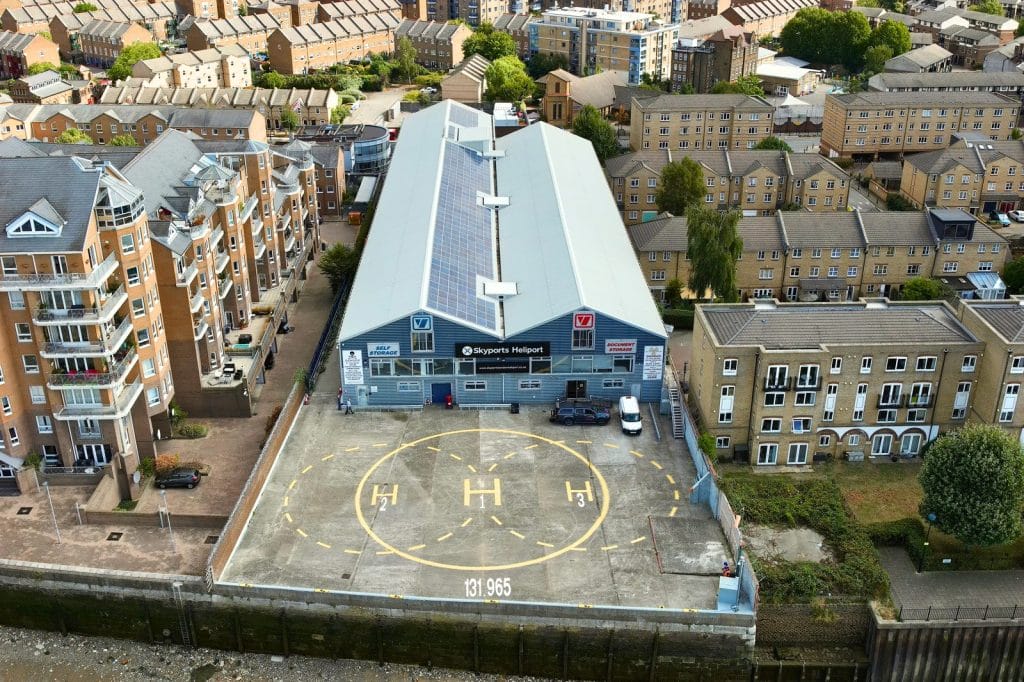Skyports London Heliport (SLH), one of two commercial heliports in London, was acquired by Skyports in December 2021 as a hub for testing AAM technologies in a live flight environment within an urban setting. In this Q&A, David Stubbersfield, Tech Lead – IT Development, outlines the technologies and procedures that are being developed at the site.

What role does SLH play in the development of Skyports’ infrastructure network – how is this likely to evolve in the next 12 months, 3 years, 5 years?
Skyports London Heliport (SLH) is an invaluable asset for the Skyports technology team. The current roadmap based on the broader Advanced Air Mobility (AAM) industry view foresees commercial operations beginning sometime in 2024. However, Skyports benefits from having access to this existing operational ground infrastructure now to support the implementation and verification of vertiport technology concepts. SLH provides a real life testing ground for future capabilities. We have currently deployed a majority of our technology baseline to the heliport and are commencing testing in an operational environment.
In the mid-long term, Skyports’ technology baseline will need to be ‘ruggedised’ so that it is capable of supporting Day 1 eVTOL operations at SLH. For example, we will deploy a more fit-for-purpose sensors and weather systems as opposed to the test versions we currently have in place. System redundancy, throughput and regulatory requirement will be central to this move towards the implementation of permanent solutions.
What technology and capabilities are you testing and what progress have you achieved so far?
The Skyports technology team has worked hard over the past 12-18 months to establish a technology baseline which is capable of supporting AAM operations. We have deployed the majority of this to SLH. A shortlist of those capabilities are:
- A representative weather system which feeds a web dashboard so operators can view weather information and predictions in real time.
- Representative VHF ground-to-air radio for listening to air traffic control (ATC) comms and communicating with pilots.
- ADS-B receiver for visualising the airspace around the heliport, identical to our vertiport ADS-B system.
- CCTV and airside situational awareness camera system, identical to our vertiport system.
- Noise monitor which allows us to capture heliport noise and associate it with helicopter operations. This data is invaluable and is used to compare with eVTOL noise captured with an identical system and also to quantify that we’re meeting our commitments to the local community in terms of noise pollution.
We are aware of the fact that AAM use cases and the technology to support those use cases is continuously evolving. Our technology baseline and its deployment at SLH also evolves over time to meet these changing requirements, thus positioning Skyports to lead the technology roadmap for ground infrastructure.

Why does a live heliport make for a good location to test vertiport technology – to what extent is the data collected from helicopter operations transferrable and applicable to an AAM setting?
One of the key question which we strive to understand further and build our expertise in is: ‘In the world of AAM, how do we foresee aircraft operators interacting with ground infrastructure operators?’
To help us explore different scenarios for this interaction, we have deployed our Vertiport Resource Management and Scheduling System (RMSS) at the heliport. Our heliport operations manager acts as the conduit between helicopter operators and our ground infrastructure. The operations manager ensures that all operator requests are fed into our RMSS system to reserve the appropriate resources at the heliport. This enables Skyports to operationally validate our RMSS system and guide the AAM industry towards standard and proven interaction points between aircraft operators and vertiport operators.
How do the learnings from SLH apply to other markets, for example the US, APAC and Middle East? Will learnings be shared?
One of the core principles of Skyports technology is developing and deploying technology which is OEM and aircraft operator agnostic. We see this as a key differentiator from our competitors. However, the core principle of being agnostic also helps us to seamlessly transfer our technology and learnings to other markets without much effort, thus enabling faster time to market for a technology product which is already proven in a similar environment. This allows us to scale and support global operations with a small and highly capable team.

Is Skyports working with any partners at SLH – or are there plans to bring partners onboard at a later date?
The systems we are designing will be a pragmatic mix of Skyports home-grown IP and technology provider offerings, ensuring that appropriate technology is used for solving the AAM use cases in the most efficient manner.
Our approach to technology development is to consciously analyse the Build vs Buy decision based on our capabilities and technology vision. We don’t want to reinvent the wheel if there is a suitable technology that will enable us to meet our operational objectives, but where a Skyports proprietary technology will add value, we will pursue that route.
This approach positions the team to explore and work with world class technology companies who have the right products and the mindset to enable Skyports to lead the vertiport technology landscape.

How much of the technology being developed and tested at Skyports is bespoke or proprietary versus “off the shelf”?
It all depends on the use cases we are solving for. There are certain aspects of vertiport which we want to be in control of using our own, bespoke technology. However, bespoke doesn’t mean that our own technology is not open for integration, rather it ensures we are in control of the overall direction and ultimate ownership of the technology. In certain instances, we believe this will be extremely valuable.
Conversely, though, there are many aspects of the vertiport technology stack for which we believe the right technology solution already exist. In those instances and use cases, we conduct deep technical due diligence to understand how off the shelf solutions can be used alongside Skyports solutions.